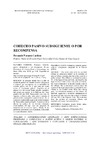Identificador persistente para citar o vincular este elemento:
https://accedacris.ulpgc.es/jspui/handle/10553/55703
| Campo DC | Valor | idioma |
|---|---|---|
| dc.contributor.author | Navarro Cardoso, Fernando | en_US |
| dc.date.accessioned | 2019-06-07T16:20:19Z | - |
| dc.date.available | 2019-06-07T16:20:19Z | - |
| dc.date.issued | 2016 | en_US |
| dc.identifier.issn | 1695-0194 | en_US |
| dc.identifier.other | Dialnet | - |
| dc.identifier.uri | https://accedacris.ulpgc.es/handle/10553/55703 | - |
| dc.description.abstract | El presente trabajo lleva a cabo un estudio dogmático del llamado cohecho subsiguiente o cohecho por recompensa, en la modalidad de cohecho pasivo, esto es, el que tiene por sujeto activo al funcionario público. Regulado en el artículo 421 del Código Penal, adquirió sustantividad propia con motivo de la Reforma del Texto punitivo del año 2010. Transcurridos unos años de vigencia, se lleva a cabo, salvo error u omisión, el primer estudio monográfico sobre el mismo. No se soslaya el controvertido aspecto de la determinación del bien jurídico-penal protegido. A partir de ahí se efectúa un análisis de los distintos elementos conformadores del tipo –con una propuesta de restricción de la conducta típica–, además de los problemas concursales que se plantean, culminando con unas reflexiones finales. | en_US |
| dc.description.abstract | This work deals with the so-called offence of subsequent bribery in its modality of passive bribery, meaning that the author must be a public servant. This offence is contained in Article 421 of the Spanish Criminal Code, introduced by the legal reform of 2010. After a few years of validity, this work is believed to be the first specific study of this offence. The controversial question about the content of the legal interest that is protected by this offence is not avoided either. From this starting point, the definitional elements of the offence are analyzed, suggesting a restrictive interpretation of the norm and also analysing the content of Articles 419 and 420 of the Criminal Code. The work also faces the problem of concurrent offences and concludes with some final considerations. | en_US |
| dc.language | spa | en_US |
| dc.relation.ispartof | Revista electrónica de ciencia penal y criminología | en_US |
| dc.source | Revista electrónica de ciencia penal y criminología[ISSN 1695-0194], n. 18, p. 25-0 | en_US |
| dc.subject | 560505 Derecho penal | en_US |
| dc.subject.other | Corrupción | en_US |
| dc.subject.other | Cohecho pasivo | en_US |
| dc.subject.other | Cohecho subsiguiente | en_US |
| dc.subject.other | Integridad de la función pública | en_US |
| dc.title | Cohecho pasivo subsiguiente o por recompensa | en_US |
| dc.type | info:eu-repo/semantics/article | en_US |
| dc.type | Article | en_US |
| dc.identifier.url | http://dialnet.unirioja.es/servlet/articulo?codigo=5788854 | - |
| dc.description.lastpage | 0 | en_US |
| dc.identifier.issue | 18 | - |
| dc.description.firstpage | 25 | en_US |
| dc.investigacion | Ciencias Sociales y Jurídicas | en_US |
| dc.type2 | Artículo | en_US |
| dc.contributor.authordialnetid | 554412 | - |
| dc.identifier.dialnet | 5788854ARTREV | - |
| dc.utils.revision | Sí | en_US |
| dc.identifier.ulpgc | Sí | en_US |
| dc.contributor.buulpgc | BU-DER | en_US |
| dc.description.dialnetimpact | 0,0 | |
| dc.description.dialnetq | Q1 | |
| dc.description.dialnetd | D1 | |
| item.grantfulltext | open | - |
| item.fulltext | Con texto completo | - |
| crisitem.author.dept | GIR Sociedad y Derecho | - |
| crisitem.author.dept | Departamento de Derecho Público | - |
| crisitem.author.orcid | 0000-0001-5316-3645 | - |
| crisitem.author.parentorg | Departamento de Derecho Público | - |
| crisitem.author.fullName | Navarro Cardoso, Fernando Carlos | - |
| Colección: | Artículos | |
Visitas 1
753
actualizado el 10-ene-2026
Descargas
244
actualizado el 10-ene-2026
Google ScholarTM
Verifica
Comparte
Exporta metadatos
Los elementos en ULPGC accedaCRIS están protegidos por derechos de autor con todos los derechos reservados, a menos que se indique lo contrario.
